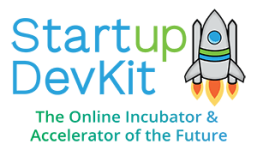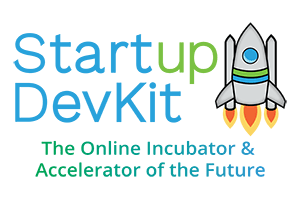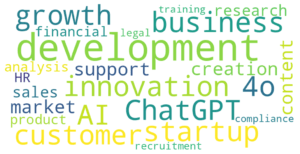Sales are the most important thing for a startup and it’s the best predictor of success and sustainability for your company. The new top reason for startup failure is startup running out of cash. So it would make sense tackle startup sales if you want to succeed, right?
Whether you’re a founder, CEO, or a startup marketer, understanding the ins and outs of startup sales is crucial for sustained growth. You will also learn how to create your own playbook from the content in this mega-post. Making your own playbook will enable you to have an organized and well thought out strategy to enable your growth.
Moreover, if you plan to raise capital, remember that investors are seeking great investments, and they’re going to want to see the viability of your company long-term. The more sales you generate and the more sustainable you become, the more likely you are to raise capital from investors, and thus, scale faster.
However, with a killer sales operation, you can put your startup in a position to succeed without needing any investment.
So how do you do it? Start by using this startup sales playbook to grow your skills, help you make your own playbook, and skyrocket your chances of success.
In this comprehensive guide, we’ll delve into the key strategies tailored for pre-seed, bootstrapped, and seed-stage founders, along with startup marketers.
And, we’ll go from the basics and move to more advanced content as we go through this mega-sized sales playbook.
Now, let’s start elevating your sales game!
Table of Contents
- Understanding Your Target Audience
- Founder-Led Sales
- Developing a Unique Value Proposition
- The Sales Process
- Navigating Objections and Closures
- Crafting Compelling Sales Pitches: Navigating Warm, Cold, and Conversational Approaches
- Social Selling, Conversational Selling, and Relationship Networking: The Human Touch in Sales
- Becoming Successful with Account-Based Marketing (ABM)
- Decoding Varied Sales Processes: Tailoring Strategies for Success
- Organic Leads vs. Email Lists: Nurturing Growth Responsibly
- The Startup Sales Funnel: A Tactical Approach
- Setting Clear Sales Objectives
- Essential Sales Metrics and KPIs
- Conclusion
The Role of a Startup Sales Playbook
A sales playbook is more than a document; it’s your strategic roadmap for revenue generation. For founders and startup marketers, it serves as a dynamic guide, aligning your team with the mission and ensuring everyone is on the same page. If you have under 100 customers, use a combination of this playbook and this guide on how to get your first 100-500 customers for your startup.
Why Does Every Startup Need a Sales Playbook?
Startups with a structured sales playbook are 33% more likely to be high-performing. This blueprint not only streamlines your sales process but also empowers your team with a unified approach, maximizing efficiency and impact.
1. Understanding Your Target Audience
In the startup world, knowing your audience is half the battle. As a founder or startup marketer, understanding your target audience lays the foundation for effective sales strategies. Let’s dive into the intricacies of defining and identifying your ideal customer profile.
Defining Your Ideal Customer
Creating a successful sales playbook begins with identifying the individuals or businesses most likely to benefit from your product or service. And for pre-seed, bootstrapped, and seed-stage startups, this means going beyond demographics – delve into psychographics, pain points, and aspirations.
1) How Do You Conduct Effective Customer Research?
Start by leveraging online surveys, interviews, and competitor analysis. Analyze your website and social media analytics for valuable insights. Additionally, actively engage with potential customers on forums and social platforms. The key is to go beyond assumptions and gather real data to refine your ideal customer profile.
2) Crafting Detailed Buyer Personas
Your buyer personas should be living documents, evolving as your startup grows. Include detailed information such as job roles, challenges, and preferred communication channels. For example, a bootstrapped SaaS startup targeting solo entrepreneurs might create a persona named “Solo Sam” – a tech-savvy professional seeking affordable, user-friendly solutions.
The staggeringly visually-outdated yet still astoundingly relevant buyer persona infographic below shows you how you can accomplish crafting a detailed buyer persona.
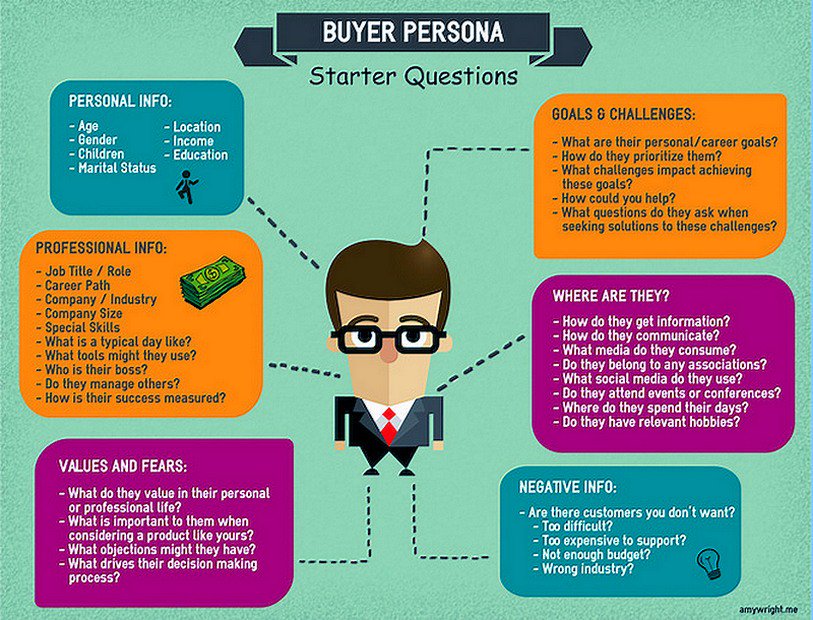
3) The Significance of Knowing Your Audience
Understanding your audience goes beyond product development; it directly influences your sales and marketing strategies.
Your audience is the entire basis of your company. And to find your most likely customers, you really have to know who they are, what they’re like, and where they gather.
Learn more about how to build customer profiles and buyer personas.
2. Founder-Led Sales

Navigating the Sales Process in Early-Stage Startups
Founders, especially CEOs, play a pivotal role in their startup’s sales. Before scaling up, it’s essential for founders to be hands-on, understanding the nuances of the entire sales process. Let’s explore why founders need to don the sales hat and lead by example.
As the driving force behind the startup, Founder & CEOs are the face of the company. In early stages, they often act as the primary salesperson, engaging directly with clients and investors. The founder is the the primary person responsible for end-to-end marketing and startup sales. If that’s you, you’ll be engaged in prospecting, lead generation, meetings, and closing sales. This hands-on approach not only instills confidence but also provides invaluable insights into customer needs.
Advantages of Founder-Led Sales:
- Passion and Conviction:
- Founders are typically deeply passionate about their product or service. Your genuine belief and enthusiasm can be contagious, resonating well with potential customers.
- In-Depth Product Knowledge:
- With unparalleled product/service understanding, founders address details, overcome objections, and tailor pitches to specific needs.
- Storytelling and Vision Sharing:
- Founders are often the best storytellers for the company’s origin, vision, and mission. To that end, sharing the journey and vision behind their startup creates a compelling narrative that connects with customers more personally.
- Flexibility and Adaptability:
- Founders are typically more flexible and adaptive in the early stages of a startup. They can quickly iterate on sales strategies, respond to market feedback, and pivot if necessary.
- Building Relationships:
- Personal connections matter in business. Founder-led sales allow for relationship building with early customers. Further, this personal touch leads to stronger customer loyalty and potential referrals.
- Quick Decision-Making:
- Founders can make decisions swiftly without bureaucratic delays. This agility is crucial, especially in the fast-paced, dynamic environment of early-stage startups.
- Demonstrating Leadership:
- Founder involvement in sales showcases leadership and commitment. It sends strong signals to both the team and potential customers that the founder is hands-on and deeply invested in the success of the business.
- Feedback:
- Directly interacting with customers enables you to gather immediate feedback. This feedback loop is invaluable for refining the product, improving sales strategies, and making data-driven decisions.
- Cost-Efficiency:
- Resources are limited and founder-led sales is cost-effective. It eliminates the need for a dedicated sales team, allowing founders to allocate resources strategically.
- Building Trust:
- Customers place trust in the founders themselves. Being involved in sales builds a sense of authenticity and trust, which is particularly crucial in the early stages when the startup is establishing its reputation.
- Understanding Market Dynamics:
- Founder-led sales provide firsthand insights into market dynamics, customer pain points, and competitive landscapes – helping to make informed strategic decisions.
Three Ways of Selling Without a Product
1) Sell Pre-Orders for Your Future Product
Imagine shaping the future with your customers. Leverage the power of anticipation by offering pre-orders for your upcoming product. This not only validates market interest but also provides crucial early funds for development. Your story becomes a prelude to a product that your customers are eager to be a part of. These people are the early adopters who are likely to stick with you for a while because they believe in you.
Tip: Craft a compelling narrative around your product’s journey and what you envision it to be, making every pre-order not just a sale but a shared adventure.
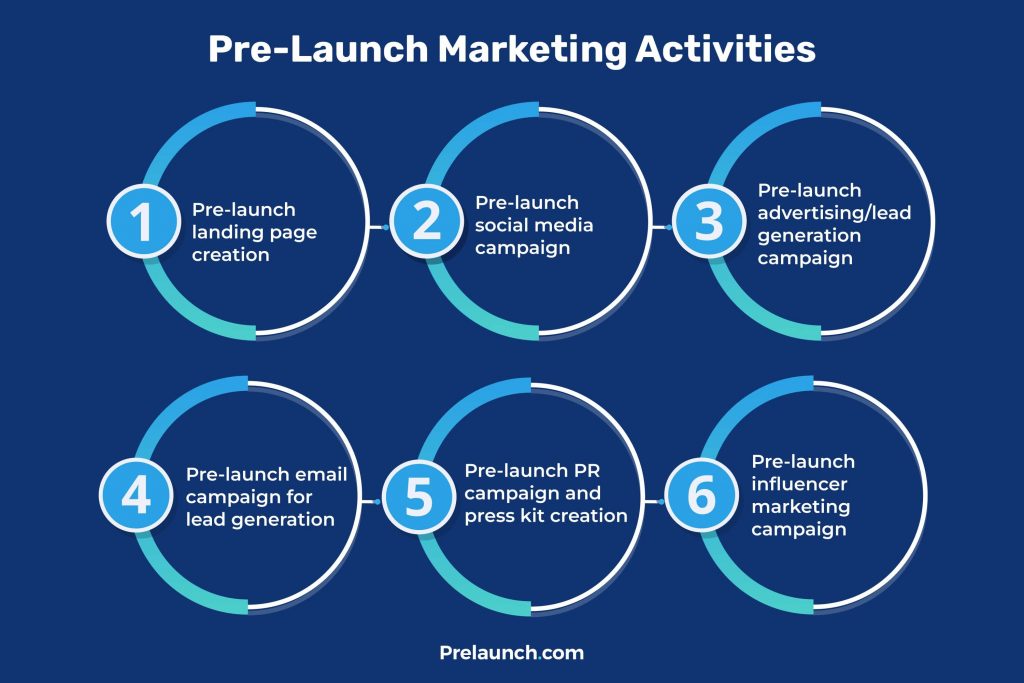
2) Sell Your Time and Experience
In the startup industry, time is a precious commodity as you race against the clock to make headway or fail trying. One way you can get started with making money before you have a product is to offer your time and expertise as a premium service.
Whether it’s personalized consultations, workshops, or mentoring sessions, your unique insights become a sought-after commodity. This not only generates revenue but also establishes you as a thought leader. You can also get testimonials through this if you’re ultimately selling an information-based product or something similar.
Tip: Tailor your offerings to address specific pain points of your target audience, showcasing the immediate value of your time and experience.
3) Sell Information
Package your expertise into informational products like e-books, webinars, or online courses. By sharing your insights, you not only position yourself as an authority but also create an additional revenue stream.
Tip: Focus on delivering practical value. Your goal is not just to sell information but to empower your audience with actionable knowledge.
Balancing Leadership and Sales Responsibilities
While wearing multiple hats is inherent in startup life, founders must strike a balance. Delegating tasks strategically and utilizing available resources effectively ensures that sales efforts align with the broader company goals. Founders may need to balance their time between sales and other critical aspects of growing the business. However, the initial involvement of founders in sales can set a strong foundation for the startup’s growth.
3. Developing a Unique Value Proposition
Crafting a Compelling Message for Startup Success
In the crowded startup landscape, having a unique value proposition (UVP) is your ticket to standing out. For pre-seed, bootstrapped, and seed-stage founders, as well as startup marketers, mastering the art of crafting a compelling message is paramount. Let’s explore the intricacies of developing a UVP that resonates with your audience and drives sales.
Understanding the Power of a Unique Value Proposition
Your UVP is the essence of why customers should choose your product or service over competitors. It’s more than just a tagline; it encapsulates the unique benefits and value your startup brings to the table.
1. Defining Your Startup’s Unique Value Proposition
Start by identifying the distinct features or benefits that set your offering apart. This could be innovation, cost-effectiveness, unparalleled customer service, or a combination of factors. As a startup, your agility and personalized approach can be integral components of your UVP.
Your UVP is the most essential aspect in your quest to dominate your startup’s sales and make it big.
A UVP is needed in your pitches, on your homepage, all of your social accounts, business plan, executive summary, etc.
How Can I Identify My Unique Value Proposition?
Your startup should fill a need in the market. It may be untapped or there may be competitors. But you have to demonstrate what makes it both unique and valuable for your target customers.
Do you have a competitive advantage? If so, write it down and mention that in your UVP.
It should be as simplistic as possible and shared in the fewest words possible. If you can’t explain it quickly and concisely, your audience won’t get it or they’ll get turned off.
Remember, people have short attention spans, especially on their devices.
Consider conducting A/B testing for different value propositions to see which resonates most with your audience. But if you do enough outreach, you’ll also be able to read people’s body language and listen to how they respond.
If you’re still in the idea phase, you can analyze competitor offerings to pinpoint gaps you can fill and interview your ideal users to pinpoint it.
2. Addressing Customer Pain Points
An effective UVP directly addresses the pain points of your target audience. Whether you’re providing a solution to a common problem or fulfilling an unmet need, understanding what keeps your customers awake at night is the key to creating a compelling value proposition.
Question: How Do I Identify Customer Pain Points?
Conduct surveys, interviews, or use social media to engage with your audience directly. Analyze customer reviews and feedback for recurring themes. The more intimately you understand your customers’ challenges, the better you can tailor your UVP to address them.
While addressing pain points, share the benefits and not the features. For instance:
- Are you saving them time or money?
- Are you making them more productive or efficient?
- Does your product reduce their stress or provide them with the information to learn something valuable or unique?
- Does your startup improve their social standing?
3. Crafting a Compelling Value Proposition Statement
Your UVP should be concise, clear, and impactful. Avoid industry jargon and focus on language that resonates with your target audience.
For instance, a bootstrapped SaaS marketplace startup might craft a UVP like, “We built the first online marketplace that lets travelers book rooms with locals, instead of hotels.”
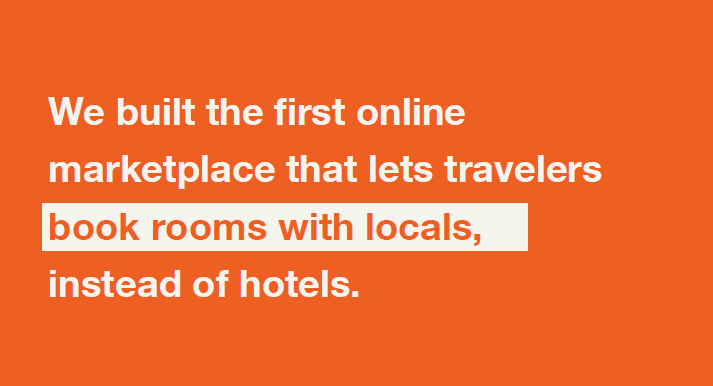
Question: How Can I Ensure My UVP Resonates?
Test your UVP with a small segment of your audience and measure the response. Iterate based on feedback and performance metrics. A resonant UVP not only attracts but also retains customers.
Question: How do I know which UVP to use when crafting so many possible UVPs?
Choosing the right UVP can be challenging, especially when you have multiple possibilities. Start by prioritizing the key pain points your target audience faces. Your selected UVP should directly address these pain points while aligning with your brand identity. Conduct A/B testing to gauge audience response and iterate based on the most effective messaging and ask people for feedback.
4. Describing Your UVP with Comparisons
To make your UVP more relatable, consider describing it by drawing comparisons with existing brands or technologies. This technique provides a shorthand way for your audience to understand the unique blend of offerings your startup brings to the market. For example, “We’re like Netflix meets VR, delivering an immersive entertainment experience in the comfort of your home.”
Example 1: “Uber for Dog Walking”
UVP Description: “Imagine the convenience of Uber seamlessly integrated with the love and care your pet deserves. We’re the Uber for dog walking, bringing reliable and on-demand pet care services to your doorstep.”
Example 2: “Spotify Meets Language Learning”
UVP Description: “Our platform combines the personalized music experience of Spotify with the immersive world of language learning. Say goodbye to mundane lessons; we’re like Spotify meets language learning, making every session an enjoyable journey.”
5. Aligning Your UVP with Sales Strategies
Once your UVP is defined, integrating it into your sales strategies is crucial. For founders and marketers, this means aligning every touchpoint, from marketing collateral to sales pitches, with the central message of your unique value proposition.
6. Infusing Your UVP into Sales Pitches
Tailor your sales pitches to highlight how your product or service directly addresses customer pain points. Whether it’s through case studies, testimonials, or live demonstrations, ensure your UVP takes center stage in every interaction.
Question: How Can I Make My Sales Pitches UVP-Centric?
Train your sales team to understand the intricacies of your UVP. Provide them with real-world examples of how the UVP has positively impacted customers. Encourage them to share stories that illustrate the transformative power of your offering.
7. UVP in Marketing Collateral and Online Presence
Your UVP should permeate all aspects of your brand’s presence. From website copy to social media posts, consistently communicate the unique value you bring to your audience. This creates a cohesive brand image that resonates with potential customers.
Question: Should My UVP Evolve Over Time?
While the core elements of your UVP may remain constant, it’s essential to adapt it as your startup evolves. Stay attuned to market trends, customer feedback, and shifts in your industry to ensure your UVP remains relevant and compelling.
8. The Impact of a Strong UVP on Sales
Startups with a well-defined UVP experience a 34% higher conversion rate (source: ConversionXL). This underscores the tangible impact a compelling message can have on your bottom line.
4. The Sales Process
Navigating the Path to Conversions
In the realm of startup success, mastering the sales process is a crucial art. For pre-seed, bootstrapped, and seed-stage founders, as well as startup marketers, understanding each stage of the sales journey and applying strategic finesse can be a game-changer. Let’s delve into the intricacies of the sales process and how it aligns with startup growth.
1. The Fundamental Stages of the Sales Process
Stage 1: Prospecting and Lead Generation
At the outset, identifying potential customers (prospecting) and generating leads are paramount. This involves researching and targeting individuals or businesses that align with your target audience.
Question: How Can I Enhance Prospecting Efforts?
Leverage data analytics and customer relationship management (CRM) tools to identify high-value leads. Here are the top seven CRMs, including HubSpot, that can enhance your prospecting efforts:
If you’re a solo founder or working in a small team without a dedicated marketing department, taking a hands-on approach is essential. Use CRM tools that offer user-friendly interfaces and scalability. Many CRMs, including HubSpot, provide resources and tutorials for individual users. Tailor your CRM implementation to your specific needs and allocate time for regular data maintenance.
Stage 2: Initial Contact and Qualification
Once leads are identified, initiating contact is the next step. Qualifying leads involves determining if they fit the criteria of an ideal customer. This stage lays the foundation for more personalized interactions.
Question: What Qualifies a Lead?
Consider factors such as budget, authority, need, and timeline (BANT) to assess lead qualification. Ensure your team is equipped with clear qualification criteria to prioritize efforts effectively.
Stage 3: Needs Assessment and Solution Presentation
Understanding the unique needs of your potential customers is pivotal. Conduct thorough needs assessments, and tailor your solution presentation to showcase how your product or service addresses their pain points.
Question: How Do I Tailor Solutions for Each Prospect?
Utilize customer feedback and market research to customize your solution presentations. Highlight specific features or benefits that directly align with the identified needs of each prospect.
Stage 4: Overcoming Objections and Concerns
Understanding Objections
Objections are a natural part of the sales process and often indicate a potential customer’s concerns or uncertainties. Successful founders and sales teams view objections as opportunities to clarify, build trust, and ultimately move the prospect closer to a positive decision.
We’ll more thoroughly address objections in the next major section: Navigating objections and closures
Four Common Types of Objections:
- Price Objections: Concerns about the affordability or perceived value of the product.
- Product Fit Objections: Questions about how well the product meets specific needs.
- Authority Objections: When the decision-maker is not part of the conversation.
- Competition Objections: Comparisons with competitors’ offerings.
Stage 5: Closing the Deal
The pinnacle of the sales process is the closing stage. It involves securing a commitment from the prospect, whether it’s a signed contract, a purchase, or another agreed-upon commitment.
Question: How Can I Improve Closing Rates?
Implement closing techniques such as the assumptive close or the alternative choice close. Provide incentives or limited-time offers to create a sense of urgency. Analyze successful deals to identify patterns and refine closing strategies.
Stage 6: Post-Sale Follow-up and Relationship Building
The Importance of Post-Sale Follow-up
Post-sale follow-up is a critical component of customer satisfaction and long-term relationship building. It’s an opportunity to reinforce value, address any concerns, and pave the way for future collaboration. Effective methods and strategies for post-sale follow-up include:
1. Personalized Thank-You Messages:
- Send personalized thank-you emails or messages expressing gratitude for the customer’s trust and decision to choose your product or service.
2. Ongoing Communication:
- Establish a schedule for regular check-ins. This could include monthly or quarterly updates, ensuring the customer feels supported and valued.
3. Surveys and Feedback Requests:
- Solicit feedback through surveys to understand the customer’s experience. Use their insights to make improvements and demonstrate a commitment to continuous enhancement.
4. Exclusive Offers and Resources:
- Provide exclusive offers or access to premium resources as a token of appreciation. This not only strengthens the customer relationship but also encourages loyalty.
5. Proactive Issue Resolution:
- Monitor for any potential issues or challenges the customer might face and proactively address them. Swift issue resolution enhances customer trust and satisfaction.
Post-Sale Follow-up Schedule
Same Day: Immediate Thank-You
- Send a personalized thank-you message immediately after the purchase.
After Seven Days: Check-In
- Follow up to ensure the customer is satisfied and address any early concerns.
Week 4: Feedback Request
- Send a survey or request feedback to gather insights into their overall experience.
Month 2: Exclusive Offer
- Provide an exclusive offer or access to premium resources as a gesture of appreciation.
Ongoing: Regular Check-Ins
- Establish a schedule for regular check-ins to maintain an ongoing connection.
2. Tailoring Sales Strategies to Your Startup’s Stage
Recognizing that each startup stage demands unique sales strategies is pivotal. Tailoring your approach based on the maturity of your business ensures that efforts are focused and effective.
Pre-Seed Stage
During the pre-seed stage, emphasize building brand awareness and refining your value proposition. Invest in prospecting strategies to lay the groundwork for lead generation as you prepare for initial market entry.
Bootstrapped Stage
Bootstrapped founders should optimize cost-effective lead generation and qualification processes. Leverage organic growth strategies, social selling, and customer referrals to expand your customer base without significant financial investment.
Seed Stage
At the seed stage, focus on scaling lead generation efforts and refining your sales pitch. Implement data-driven decision-making to enhance prospecting efficiency and leverage seed funding to invest in targeted marketing campaigns.
Aligning Sales Strategies with Business Goals
Ultimately, the sales process must align seamlessly with broader business goals. Whether it’s achieving revenue targets, expanding market share, or fostering customer loyalty, every sales effort should contribute to the overarching success of the startup.
The Impact of Strategic Sales Mastery
Startups that strategically master the sales process experience a 15% increase in customer retention and a 20% boost in revenue growth (source: HubSpot). This underscores the transformative power of strategic finesse in navigating the path to conversion.
5. Navigating Objections and Closures
You may come across some objectionable objections, but you still need to rebut them nonetheless to convince and win over the mind of the prospect. Objections can range from pricing issues to doubts about product functionality.
1. Understanding and Overcoming Sales Objections
Creating an Objection-Handling Framework
An objection-handling framework provides a structured approach for addressing objections effectively.
Here’s a step-by-step guide to creating one:
Step 1: Identify Common Objections
Analyze past sales interactions and customer feedback to identify recurring objections. Categorize objections based on themes to streamline your framework.
Step 2: Understand the Root Causes
Dive deeper into each objection to understand its root cause. This involves considering the prospect’s perspective and motivations.
Step 3: Develop Standard Responses
Create standard responses for each objection. These responses should be clear, concise, and empathetic, addressing the prospect’s concerns while emphasizing the value your product or service brings.
Step 4: Customize Responses
While having standard responses is essential, customization is key. Tailor your responses based on the specific context of the prospect and the nuances of their objection.
Step 5: Implement Role-Playing
Conduct role-playing exercises with your sales team to practice objection-handling scenarios. This builds confidence and ensures that your team is well-prepared for real-world objections.
Step 6: Integrate Objection-Handling into Sales Training
Make objection-handling an integral part of your ongoing sales training. Ensure that new team members are familiar with the framework and experienced members receive regular refreshers.
Overcoming Specific Objections
Price Objections:
- Question to Ask: “Can you help me understand your budget constraints better?”
- Response: Highlight the value proposition and return on investment. Offer flexible payment plans or discounts for extended commitments.
Product Fit Objections:
- Question to Ask: “Which specific features are crucial for your needs?”
- Response: Tailor your pitch to emphasize how your product meets those specific needs. Provide case studies or testimonials from similar customers.
Authority Objections:
- Question to Ask: “Is there anyone else in your team we should involve in this discussion?”
- Response: Emphasize the importance of having all decision-makers on board. Offer to schedule a follow-up meeting with the relevant stakeholders.
Competition Objections:
- Question to Ask: “What aspects are you comparing, and how important are they to your decision?”
- Response: Provide a detailed comparison of features and benefits. Showcase unique selling points that competitors may lack.
In the dynamic landscape of startup sales, objections are inevitable roadblocks. Anticipating and addressing objections is an art that founders and marketers must master to propel their sales process forward.
Hurdle 1: Price Concerns
How to Overcome: Address the value your product brings. Showcase ROI and highlight long-term benefits. According to a study by Sales Hacker, 60% of objections are related to pricing, emphasizing the importance of articulating value.
Hurdle 2: Product Fit Uncertainty
How to Overcome: Demonstrate how your product precisely meets their needs. Leverage case studies or success stories from similar clients. A report by Gartner indicates that 87% of buyers find case studies influential in their purchasing decisions.
Hurdle 3: Timing Issues
How to Overcome: Understand their timeline and align your pitch accordingly. Showcase the immediate gains or problem-solving aspects of your product that can be implemented swiftly. According to HubSpot’s Research, aligning with the prospect’s timeline increases the likelihood of a successful deal.
Hurdle 4: Competition Comparisons
How to Overcome: Differentiate your product by highlighting unique features and benefits. Showcase customer testimonials that emphasize your strengths over competitors. A Forrester study found that 70% of buyers read testimonials before making a purchase decision.
Common Objection-Handling Questions:
How do I handle objections without sounding defensive?
Acknowledge the concern, empathize, and pivot the conversation to highlight the positive aspects of your solution.
What if the objection catches me off guard?
Stay composed. Request more information to better understand their perspective, and take a moment to formulate a thoughtful response.
2. Closing Techniques

Closing a deal is not a one-size-fits-all scenario. Tailoring your approach to the prospect’s buying signals is key.
Here are four effective closing techniques to try:
Technique 1: Try The Assumptive Close
How to Implement: Assume the prospect is ready to move forward. Use phrases like “When would you like to get started?” to guide them towards a decision.
Technique 2: The Choice Close
How to Implement: Present two or more options, giving the prospect a sense of control. For example, “Would you prefer the basic package or the premium option?” A Harvard Business Review study found that giving choices increases the likelihood of a positive decision. Moreover, it takes out ambiguity and leads them towards one of those choices.
Technique 3: The Summary Close
How to Implement: Recap the key benefits and agreements throughout the conversation. Summarizing reinforces the value and encourages a positive decision. But when you do make sure you’re summarizing how your solution helps the prospect accomplish their goals.
Technique 4: The Urgency Close
How to Implement: Create a sense of urgency by highlighting limited-time offers, special promotions, or imminent changes in pricing. Prompting action boosts decision-making.
One entrepreneur found creating a sense of urgency increased his sales by 332%.
Common Closing Technique Questions:
How do I know when it’s the right time to close?
Look for buying signals, such as positive body language, verbal agreement, or a keen interest in specific features. Recognizing buying signals is crucial for timely closures.
What if the prospect is still hesitant during the closing stage?
Address any remaining concerns, reemphasize benefits, and offer additional reassurances.
6. Crafting Compelling Sales Pitches: Navigating Warm, Cold, and Conversational Approaches
Excelling with Your Sales Pitch
In the startup arena, where attention is a precious commodity, your sales pitch is the key to unlocking doors. Whether you’re reaching out to warm leads through referrals or initiating contact with a cold audience, the way you craft and deliver your pitch is pivotal.
Research by Salesforce finds that 89% of buyers are more likely to make a purchase if a company demonstrates an understanding of a potential customer’s goals. This is akin to understanding their pain points and you’re going to help them reach their goals.
1. Crafting an Irresistible Pitch
Your pitch should be a carefully woven narrative that not only highlights the features of your product but also resonates with the pain points of your audience. Break down your pitch into three critical components:
1. The Hook: Captivating Attention
To create an effective hook, start with a compelling statistic or a relatable story. For example, “Did you know that 85% of startup founders struggle with lead generation?”
2. The Value Proposition: Solving Problems
Clearly articulate the value your product brings. Speak directly to the challenges your audience faces, and position your solution as the ultimate remedy.
3. The Call-to-Action: Driving Action
End your pitch with a clear call-to-action. Whether it’s scheduling a demo, signing up for a trial, or making a purchase, guide your prospect towards the next step.
2. Warm Pitches vs. Cold Pitches
Understanding the nuances between warm and cold pitches is crucial for tailoring your approach:
Leveraging Referrals
Leveraging referrals is a potent strategy in the startup sales playbook. When approaching warm leads, you benefit from an existing level of trust. Here’s how to navigate warm pitches:
Building on Trust:
Leverage the existing trust factor from the referral. Highlight the mutual connection and express gratitude for the introduction.
Aligning with Needs:
Tailor your pitch to align with the specific needs or pain points of the referred prospect. Refer to the common ground established through the referrer.
Strengthening Connections:
Use warm pitches as opportunities not just to sell but to build lasting connections. Personalize your approach, showcasing genuine interest in the prospect.
According to a Nielsen survey, people are four times more likely to buy when referred by a friend, emphasizing the impact of warm pitches. Thus, this makes referral marketing, a strong strategy to use.

Cold Pitches: Initiating Contact with Precision
Cold pitches require a different strategy since you are introducing your product to an audience unfamiliar with your brand. Here’s how to navigate cold pitches:
Researching Your Audience:
Prioritize research to understand the pain points and needs of your cold audience. Tailor your pitch to address these specifics.
Establishing Credibility:
In the initial stages, establish your credibility. Highlight key achievements, notable clients, or industry recognition to instill confidence.
Crafting an Intriguing Opening:
The opening of your cold pitch is critical. Craft an intriguing opening that sparks curiosity and prompts the recipient to continue reading.
According to HubSpot Research, 78% of decision-makers surveyed have taken an appointment or attended an event based on a cold email, showcasing the potential impact of well-crafted cold pitches.
3. Common Questions about Sales Pitches:
How long should my pitch be?
Ideally, your pitch should be concise and focused. Aim for no more than two minutes for verbal pitches and a maximum of three short paragraphs for written pitches.
Is it better to lead with features or benefits in a pitch?
While features are essential, leading with benefits resonates more with your audience. Focus on showcasing how your product solves their specific problems.
4. Sales Pitches for Industry-Specific Companies: SaaS, Enterprise, Hardware, B2B, CPG
In the diverse landscape of startups, one-size-fits-all pitches fall short. The nuances of your pitch depend on the nature of your business.
Let’s explore how your approach should differ for various models:
SaaS Sales Pitch: Emphasizing Solutions
For SaaS startups, the emphasis should be on solving problems efficiently. Tailor your pitch to highlight:
Cloud-Based Efficiency:
Emphasize the flexibility and accessibility of your cloud-based solution. Cloud-based solutions often provide a reduction in costs. Highlight how your SaaS product streamlines processes and enhances efficiency.
Scalability Features:
Showcase the scalability features of your SaaS offering. Demonstrate how it can grow alongside the client’s business, adapting to evolving needs. A bustiness will often prioritize scalability in SaaS solutions because the costs of switching tools is steep due to excessive time-spent on migration and getting past the learning curve.
Integration Capabilities:
Highlight seamless integration with existing systems. An integration-friendly SaaS product is often more appealing to businesses looking for comprehensive solutions. That’s because integrations provide greater functionality with your existing tool stack. Everyone likes doing more with less!
Enterprise Sales Pitch: Building Long-Term Partnerships
Enterprise sales require a more strategic and relationship-focused approach.
Your pitch should include:
Customization and Scalability:
Enterprises seek solutions that can be tailored to their unique needs. Showcase the customizable features of your product and its scalability for enterprise-level operations. Enterprises generally prioritize customization in technology solutions, especially when paying top-dollar.
Comprehensive Support and Training:
Assure enterprises of your commitment to ongoing support and training. A robust support system is crucial for large organizations implementing new technologies.
ROI and Long-Term Benefits:
Demonstrate the long-term return on investment (ROI) your solution offers. Enterprises are keen on solutions that bring sustained value over time.
B2B Services Pitch: Demonstrating Expertise
When selling B2B services, establishing trust through expertise is key. Craft your pitch to highlight:
Industry-Specific Knowledge:
Showcase your understanding of the client’s industry. Tailor your pitch to reflect how your services align with the specific challenges and opportunities in that sector. According to HubSpot, 78% of B2B buyers consider industry-specific expertise a crucial factor in vendor selection.
Proven Results:
A DemandGen report revealed that 62% of B2B buyers rely on case studies during the decision-making process.
Therefore, present case studies and success stories that underscore the tangible results your services have achieved for similar B2B clients.
Collaborative Approach:
Emphasize a collaborative partnership. B2B clients appreciate service providers who work to collaborate with their internal teams.
Hardware Sales Pitch: Showcasing Tangible Benefits
For startups dealing in hardware, the pitch should focus on tangible benefits and features:
Innovative Technology:
Highlight the innovative aspects of your hardware. Showcase any cutting-edge technology, unique features, or patents associated with your product. Moreover, hardware consumers value easy of use and new features that enhance their experience, so do your best to present your offerings like that.
Durability and Reliability:
Address concerns about the durability and reliability of the hardware. Use statistics or testing data to reinforce the robustness of your product.
User-Friendly Design:
Emphasize user-friendly design. Whether it’s intuitive interfaces or easy setup processes, make it clear how your hardware prioritizes user experience.
CPG Sales Pitch: Connecting with Consumers
Consumer Packaged Goods (CPG) pitches should evoke a connection with the end consumer. Tailor your pitch to include:
Brand Storytelling:
Infuse your pitch with the story behind your product. Consumers resonate with brands that have a compelling narrative.
Health and Sustainability:
A Trivium Packaging report shared that 54% of consumers actively seek products with sustainability claims. This means that environmental-friendliness and sustainability are top of mind for consumers. And modern consumers prioritize products aligned with wellness and eco-friendly values.
If applicable, emphasize health benefits or sustainable practices associated with your CPG product. Utilize corn-based see-through plastic when possible because it’s biodegradable.
Visual Appeal:
Millennials and Gen Z are twice as likely to make a purchase based on online imagery than Gen X or Baby Boomers, according to a VisualGPS survey cited by Forbes.
Therefore, you should highlight the visual appeal of your product. For CPG, packaging and design play a crucial role in attracting consumers.
Common Questions about Industry-Specific Pitches:
Should I use technical jargon in my SaaS pitch?
While some technical details may be necessary, focus on clear and concise explanations.
Ensure that technical aspects are presented in a way that is understandable to a broader audience.
How can I make my hardware pitch more engaging?
Incorporate visuals, demonstrations, or prototypes into your pitch.
Showcasing the physical aspects of your hardware can be more compelling than a purely verbal description.
5. Elevating Conversations, Closing Deals
A conversational pitch isn’t just about the words you choose—it’s about fostering a genuine connection. By approaching each interaction with authenticity and adaptability, you transform your pitch from a presentation into a memorable conversation.
1. Learn About Their Goals and Pitfalls
By learning about people’s goals and pitfalls, you can better understand their needs and how your company might be able to help. Perhaps you’re a good fit and you discovered that by discovering their goals and pitfalls. Or, if you’re not a good fit, you could talk about reciprocal recommendations of people and/or companies that are better fits for each other.
Understanding their goals and pitfalls also enables you to put yourself in their shoes and showcase empathy.
2. Showcase Empathy
Empathy is a powerful tool in a conversational pitch. Show genuine understanding of the prospect’s challenges and express how your solution aligns with their needs. This emotional connection can significantly influence decision-making.
According to a Uniphore article, empathy can improve buyer decision making quality by 11%. That’s a nice increase!
3. Utilize Multi-Channel Communication
Don’t limit your conversational pitch to a single channel. Leverage email, phone calls, social media, and even video to create a more dynamic and interconnected dialogue. This multi-channel approach adds depth to your interactions.
How do I balance persistence with avoiding being too pushy?
Strive for a balance by respecting the prospect’s preferences. If they prefer email communication, respect that choice while maintaining a consistent but not overwhelming presence. Be cheerful and polite in your interactions, as well.
4. Express Gratitude and Follow-Up
End your conversation with gratitude, expressing appreciation for the prospect’s time and insights.
Then, follow up with a brief summary of key points discussed and any promised follow-up actions.
According to a study by Brevet referenced on HubSpot, 80% of sales require five follow-up calls after the meeting, emphasizing the importance of consistent follow-up.
5. Learn and Iterate
Every conversation is an opportunity to learn. Pay attention to what resonates with prospects, analyze the outcomes of your pitches, and continuously iterate based on feedback. This iterative approach enhances the effectiveness of your conversational pitches over time.
7. Social Selling, Conversational Selling, and Relationship Networking: The Human Touch in Sales

1. Elevating Sales Through Authentic Connections
The essence of sales often lies in the art of building authentic relationships. Like in the previous subsection about conversational selling, social selling and relationship networking emerge as indispensable tools for founders and marketers seeking to inject the human touch into their sales strategies.
1. The Dynamics of Social Selling
Social selling extends beyond mere online presence; it’s about strategically leveraging social media to connect with prospects and build meaningful relationships.
Establishing Authority:
Cultivate a thought leadership presence on platforms like LinkedIn and Twitter. Share industry insights, engage in conversations, and position yourself as an authority in your domain.
How do I balance self-promotion with providing value in social selling?
Strive for an 80/20 balance – 80% of your content should provide value through insights, tips, or industry updates, while 20% can be dedicated to showcasing your offerings.
Leveraging Social Listening:
Monitor social media for relevant conversations and engage with prospects organically. Social listening provides valuable insights into customer pain points and industry trends.
According to an Aberdeen study, 64% of sales professionals who use social media hit their sales targets.
2. Relationship Networking: Beyond Transactions
Building relationships transcends the transactional nature of sales. It involves fostering connections that go beyond immediate conversions, focusing on long-term trust and collaboration.
Personalized Communication:
Tailor your communication to each prospect. Whether through emails, video calls, or in-person meetings, understanding and addressing individual needs fosters a sense of personal connection.
How do I find common ground with prospects for personalized communication?
Research your prospects’ backgrounds, interests, and industry affiliations. Mention shared experiences or common goals to establish rapport.
Networking Events and Conferences:
Actively participate in industry events, conferences, and networking groups. These environments provide opportunities to forge genuine connections and expand your professional circle.
Attending professional conferences and events results in an average of 10 valuable connections per event, as reported by 76% of professionals.
3. Leveraging Technology for Authentic Engagement
While technology facilitates connections, its true power lies in enhancing the authenticity of those connections.
Personalized Automated Outreach:
Utilize automation tools for personalized outreach. Craft templates that maintain a human touch while automating repetitive aspects of communication.
Can automated outreach still be authentic?
Absolutely. Personalize automated messages with details relevant to each prospect. Use automation to streamline processes, not to replace genuine engagement.
CRM Integration for Relationship Tracking:
Integrate Customer Relationship Management (CRM) tools to track and manage interactions. This ensures a seamless flow of information and enables more informed and personalized follow-ups.
According to a survey conducted by Salesforce, 57% of sales leaders believe that AI will significantly impact their sales teams in the next three years. From predictive lead scoring to virtual assistants, AI has the power to revolutionize the way sales reps work.
But let’s go back to the more human-side of sales for startups, conversational selling.
2. Conversational Selling: A Friendly Approach to Sales
The Art of Casual Professionalism
In the dynamic world of startup sales, the ability to engage prospects in a natural conversation is a valuable skill. A conversational pitch creates a connection, making your interaction more memorable and enjoyable for the prospect.
1. Know Your Audience
Understanding your audience is the foundation of a conversational pitch. Research their interests, challenges, and preferences. The more you know, the more personalized and engaging your conversation can be.
Buyers expect sales reps to personalize interactions, so focus on understanding the company and the people who work in it.
Managers, VPs, C-level execs, and founders are the usually only ones who can make a purchase in an organization. And even managers seek approval from their superiors.
Also understand that decision-makers are busy and get tons of emails and social messages every day from reps looking to sell their services to them. The sheer volume is annoying in of itself.
You have to stand out from the rest of the pack and make a great impression.
2. Start with a Genuine Greeting
Begin your pitch with a warm and genuine greeting. Whether it’s a simple “Hello” or a friendly acknowledgment of the prospect’s recent achievements, set a positive and inviting tone from the start.
How do I make my greeting stand out?
Your greeting should be specific and relevant. Mention a recent industry event, congratulate them on a milestone, or reference a shared interest to make it more personalized. You can praise their website, their social media content, newsletter (if you read it), events they may have had, or other content they’ve shared.
People love to feel good. If you can make people feel good in their interaction with them, it goes a long way.
3. Use Everyday Language
Avoid excessive jargon and overly formal language. Speak in a way that your prospect can easily understand. Imagine you’re explaining your product or service to a friend over coffee rather than delivering a formal presentation.
Should I use humor in a conversational pitch?
Humor can be effective, but it’s essential to gauge the prospect’s personality and the context. A light, relevant joke or anecdote can humanize the interaction.
4. Ask Open-Ended Questions
Encourage a two-way conversation by asking open-ended questions. These questions invite the prospect to share more about their needs and challenges, creating an opportunity for you to tailor your pitch accordingly.
How do I transition from small talk to the pitch?
Once you’ve established a rapport through small talk or initial questions, smoothly transition by saying something like, “I appreciate your insights. It got me thinking about how [Your Product] could potentially address [specific challenge].”
Then share your thoughts after that segue.
5. Share Stories and Examples
Integrate relatable stories and examples into your pitch if possible. Narratives resonate well in a conversational setting and help illustrate the real-world impact of your product or service.
According to an article from the Stanford VMWare Women’s Leadership Innovation Lab, stories are up to 22 times more memorable than facts alone.
6. Be Responsive and Adaptive
Conversations aren’t scripted. Be responsive to the prospect’s cues, adapting your pitch based on their reactions and feedback. This flexibility creates a more natural and engaging exchange.
What if the prospect has a specific concern during the pitch?
Acknowledge their concern, validate it, and address it openly. This transparency builds trust and demonstrates your commitment to understanding and resolving issues.
How do I gather feedback without being intrusive?
Incorporate feedback requests naturally into your follow-up communications. For example, you can say, “I’d love to hear your thoughts on our discussion. Your feedback is invaluable in refining our approach.”
Conclusion: Balancing Technology and Humanity
Crafting conversational pitches is an ongoing process of refinement. By infusing authenticity, empathy, and adaptability into your interactions, you not only elevate the conversation but also increase the likelihood of closing deals through meaningful connections.
As founders and marketers, the ability to balance technology-driven efficiency with the genuine human touch defines the success of your sales endeavors. Social selling and relationship networking are not just strategies; they are the embodiment of authentic engagement in the digital age.
Navigate this landscape with empathy, active listening, and a genuine desire to understand your audience. In doing so, you elevate your sales approach from transactional to transformative, forging connections that endure beyond the confines of a single deal.
8. Becoming Successful with Account-Based Marketing (ABM)
Unlocking Growth Through Precision and Personalization
For startups seeking a targeted and personalized approach to their marketing endeavors, Account-Based Marketing (ABM) emerges as a strategic powerhouse. ABM goes beyond traditional lead generation, focusing on engaging and converting high-value accounts rather than individual leads.
Let’s explore how startups can leverage ABM for success, which types of startups are best suited for this approach, and when it becomes relevant.
1. Defining Account-Based Marketing (ABM) for Startups
In essence, ABM is a highly focused strategy where marketing efforts are tailored for specific accounts, treating them as individual markets. Unlike broader marketing strategies, ABM aligns sales and marketing teams to collaborate in identifying and targeting key accounts with a personalized approach.
Common Question: How does ABM differ from traditional lead generation? Traditional lead generation casts a wide net to capture a broad audience. ABM, on the other hand, narrows the focus to a select group of high-value accounts, allowing for personalized and targeted campaigns.
2. Types of Startups Benefiting from ABM
While ABM can be beneficial for various startups, it is particularly advantageous for those with specific characteristics:
Complex Sales Cycles:
According to Demandbase, 72% of businesses say ABM delivers higher ROI than other marketing strategies. To that end, startups with intricate and lengthy sales cycles, often associated with B2B services or enterprise solutions, find value in ABM. The tailored approach aligns with the intricate decision-making processes of these accounts.
Limited Target Audience:
If your startup caters to a niche market or has a finite number of potential clients, ABM allows you to invest resources precisely where they matter most.
Is ABM only for B2B startups?
While ABM is widely used in B2B contexts, B2C startups with a focus on high-value clientele can also benefit by adopting modified ABM strategies.
3. When Does ABM Become Relevant for Startups?
ABM isn’t a one-size-fits-all solution, and its relevance depends on the maturity and goals of the startup.
Consider adopting ABM when:
Post-Product Validation:
Once your product or service has been validated and refined based on initial market feedback, ABM becomes relevant. This stage ensures you’re investing resources in promoting a well-received offering.
Can startups with limited resources still implement ABM effectively?
Yes, startups can start with scaled-down ABM strategies. Focus on a small number of high-potential accounts and gradually expand as resources allow.
Clear Ideal Customer Profile (ICP):
ABM is most effective when you have a clearly defined Ideal Customer Profile. Understanding the characteristics of your most valuable customers helps identify similar accounts for targeted campaigns. It also helps to know what you don’t want in a customer and who isn’t your ideal customer.
ABM Conclusion: Precision in Pursuit of Growth
In the dynamic landscape of startup marketing, ABM stands out as a beacon of precision and personalization. By aligning your marketing efforts with the unique needs of high-value accounts, startups can unlock unparalleled growth and build lasting relationships with key clients.
As your startup evolves, continually reassess the suitability of ABM within your overarching marketing strategy. Embrace its principles of focus and customization, and witness the transformative impact on your startup’s trajectory.
9. Decoding Varied Sales Processes: Tailoring Strategies for Success
Navigating the Diverse Landscape of Sales Processes
In the startup realm, founders and marketers need to grasp the intricacies of different sales processes. The ability to adapt strategies based on the nature of the business is crucial. Let’s explore tailored approaches for various sales processes:
1. Enterprise Sales: Building Relationships at Scale
Enterprise sales involve complex decision-making structures and large organizations. As a founder or marketer, understanding the nuances is essential. Here’s how to navigate the intricacies:
Relationship Building:
Prioritize relationship-building over quick transactions. Enterprises often value long-term partnerships, and establishing trust is crucial.
How do I initiate a relationship-focused conversation with an enterprise prospect?
Start by expressing genuine interest in the prospect’s business and industry challenges. Ask open-ended questions to understand their goals and pain points.
Customized Solutions:
Tailor your solutions to meet the specific needs and challenges of the enterprise. Flexibility and customization play a significant role in enterprise sales success.
How can I gather the necessary information to customize my solutions?
Conduct in-depth research on the enterprise, its industry, and competitors. Engage in discovery conversations to understand their unique requirements.
Extended Sales Cycles:
Understand that enterprise sales typically have longer sales cycles due to the large deal-size. So it’s important to exercise patience and persistence with potential buyers, as they’re waiting on decisions which often involve multiple stakeholders.
2. SaaS Sales: Emphasizing Value and Scalability
Selling Software as a Service (SaaS) products requires a focus on demonstrating value and scalability.
Here’s how to excel in the SaaS arena:
Value Proposition:
Clearly articulate the value your SaaS solution brings to users. Highlight cost savings, efficiency gains, or unique features that set your product apart.
How do I effectively communicate the value of my SaaS product in a concise manner?
Craft a succinct elevator pitch that emphasizes the immediate benefits users can experience. Therefore, focus on solving a specific problem they face.
Scalability Features:
Emphasize the scalability of your SaaS solution. Illustrate how it can grow with the client’s business, making it a long-term, adaptive investment.
What evidence can I provide to showcase the scalability of my SaaS product?
Share case studies or testimonials from clients who successfully scaled their operations using your SaaS solution.
Free Trials and Demos:
According to Gartner, offering free trials increases conversion rates by 20%. Therefore, we suggest that you offer free trials or demos to allow potential customers to experience the value of your product/service firsthand.
3. B2B Services: Building Trust Through Expertise
When selling business-to-business services, trust and expertise take center stage.
Here’s how to position your B2B services effectively:
Industry-Specific Knowledge:
Demonstrate a deep understanding of the client’s industry. Tailor your pitch to align with their unique challenges, showcasing your expertise.
How can I stay updated on industry trends to showcase my knowledge during pitches?
Regularly read industry publications, attend relevant conferences, and participate in webinars to stay informed about the latest trends.
Results-Driven Approach:
Showcase the results your B2B services have achieved for similar clients. Metrics and case studies add credibility and demonstrate tangible outcomes.
How do I balance showcasing results without sounding too self-promotional?
Frame your results in a way that emphasizes the positive impact on the client rather than solely focusing on your achievements.
Use client testimonials to validate your claims. They’re a very powerful tool to increase conversions and create trust with potential customers.
Collaborative Partnerships:
As we mentioned earlier, emphasize a collaborative approach. B2B clients, like enterprise clients, often appreciate service providers who become strategic partners in achieving mutual goals.
4. Hardware Sales: Showcasing Tangible Benefits
For startups dealing in hardware, the pitch should focus on tangible benefits and features:
Innovative Technology:
Highlight the innovative aspects of your hardware. Showcase any cutting-edge technology, unique features, or patents associated with your product.
How can I simplify complex technical details about my hardware for potential customers?
Break down technical jargon into layman’s terms, using analogies or visuals to explain complex concepts. Focus on how these technical aspects translate into real-world benefits. Doing these two things will improve your startup’s sales.
Durability and Reliability:
Address concerns about the durability and reliability of the hardware. Use statistics or testing data to reinforce the robustness of your product.
How can I build trust in the durability of my hardware, especially in a competitive market?
Offer extended warranties or guarantees to instill confidence in the durability and reliability of your hardware.
Share testimonials from satisfied customers who have experienced the longevity of your products.
What’s more, you can build additional trust by showcasing success stories and case studies from customers who found benefit from using your startup’s product/service.
5. CPG Sales: Connecting with Consumers
Consumer Packaged Goods (CPG) pitches should evoke a connection with the end consumer. Tailor your pitch to include:
Brand Storytelling:
Infuse your pitch with the story behind your product. Consumers resonate with brands that have a compelling narrative.
How do I identify the core story of my CPG product?
Focus on the journey of creating the product, the values it represents, or any unique aspects of its origin. Your story should align with the emotions you want consumers to associate with your brand. The more you can humanize your product, the more likely you are to connect with your audience and thus, increase sales.
Health and Sustainability:
If applicable, emphasize health benefits or sustainable practices associated with your CPG product. Modern consumers prioritize products aligned with wellness and eco-friendly values.
How can I communicate the health benefits of my CPG product effectively?
Use clear and simple language to explain the health advantages of your product. Incorporate visual aids or infographics to illustrate nutritional information.
Visual Appeal:
Highlight the visual appeal of your product. For CPG, packaging and design play a crucial role in attracting consumers.
How do I enhance the visual appeal of my CPG product on a limited budget?
Focus on clean and minimalist designs. Leverage cost-effective packaging solutions that convey a premium feel. Conduct small-scale market tests to gather feedback on visual appeal.
Common Questions about Industry-Specific Pitches:
Should I use technical jargon in my hardware pitch?
While some technical details may be necessary, focus on clear and concise explanations. Ensure that technical aspects are presented in a way that is understandable to a broader audience.
How do I make my greeting stand out in B2B services?
Personalize your greeting by referencing recent industry events, achievements, or shared interests. This shows attentiveness and sets a positive tone for the conversation.
10. Organic Leads vs. Email Lists: Nurturing Growth Responsibly
Striking the Balance for Sustainable Customer Acquisition
In the realm of customer acquisition, the age-old debate persists: Is it better to cultivate organic leads or invest in email lists? Striking the right balance is not only crucial for sustainable growth but also for building a customer base that is genuinely interested in your offering.
1. The Power of Organic Leads
Organic leads, those garnered through content marketing, SEO, and word-of-mouth, hold a unique potency in the world of customer acquisition.
Authentic Engagement:
Organic leads often result from authentic interactions. Whether it’s a blog post, a social media share, or a podcast appearance, these leads come to you genuinely interested in what you offer.
According to HubSpot, companies that blog receive 55% more website visitors than those that don’t.
Trust Building:
The organic approach fosters trust. When leads discover your brand through valuable content or recommendations, a foundation of trust is established from the outset.
How long does it take to see results from organic lead generation efforts?
Results vary, but according to Content Marketing Institute, it typically takes six to nine months to see significant results from content marketing efforts.
2. The Allure and Risks of Purchased Email Lists
Purchasing email lists can seem like a shortcut to a sizable contact database, but it comes with its set of challenges and risks.
Immediate Reach:
Email lists offer immediate access to a broad audience. However, the question remains whether this audience is genuinely interested in your product or service.
The Direct Marketing Association found that email marketing has an impressive ROI of 4,200%, but this varies based on list quality and targeting.
Compliance and Risks:
Using purchased email lists comes with compliance risks, especially with data protection regulations like GDPR. Failure to comply can result in severe legal consequences and damage to your brand reputation.
Are there industries where purchased email lists work better?
While results can vary, industries like business services and retail may see more success with purchased lists. However, personalized, opt-in lists often outperform in terms of engagement and conversions.
3. The Middle Ground: Building Your Email List Organically
The sweet spot lies in building your email list organically while leveraging the benefits of purchased lists strategically.
Content-Driven Opt-Ins:
Create compelling content that encourages visitors to willingly opt into your email list. This ensures a more engaged and receptive audience.
How can I entice visitors to subscribe to my email list?
Offer incentives like exclusive content, discounts, or early access to products. Clearly communicate the value they’ll receive by subscribing.
Segmentation for Personalization:
According to Mailchimp, segmented campaigns can result in a 14.31% higher open rate compared to non-segmented ones. We went from a 28-32% open rate with our whole email list to ~48-52% open rate when sending our newsletter to segments of contacts who’ve opened any campaign in the last six months. And that’s just a basic segmentation.
You should segment your email list based on user behavior, preferences, and demographics. This allows for more personalized and targeted communication.
Conclusion: Crafting a Holistic Approach
In the quest for customer acquisition, the most effective strategy often lies in a holistic approach. While organic leads foster genuine engagement and trust, judiciously leveraging email lists can offer immediate reach when done ethically. Striking the right balance ensures sustainable growth and a customer base aligned with your brand values.
As you navigate this nuanced landscape, remember that quality always trumps quantity. The value of a genuinely interested lead far exceeds that of a disengaged one, setting the stage for long-term customer relationships.
11. The Startup Sales Funnel: A Tactical Approach
Welcome to the core of your startup sales playbook, where we delve into the intricacies of the sales funnel tailored explicitly for early-stage startups. This isn’t just a journey; it’s your startup’s lifeline—a methodical process designed to steer potential leads through the buyer’s journey stages of Awareness, Consideration, and Decision.

Understanding the Startup Sales Funnel Dynamics
In startup sales, envision your funnel as a dynamic playbook—an evolving strategy guiding prospects through the buyer’s journey. Each stage, from top to bottom, plays a vital role in sculpting the destiny of your startup.
1. Top of Funnel: Sparking Startup Awareness
Initiate your playbook at the top of the funnel—the Awareness stage. This is where startup sales magic begins, casting a wide net to capture the attention of potential leads. Employ content marketing, social media outreach, and buzz-worthy strategies.
Sales Method:
Strategically align your content to educate your audience about the solutions your startup provides. Establish your startup as a credible authority in the industry.
Optimization Tip:
Leverage customer relationship management (CRM) tools to track engagement metrics and optimize your content strategy based on real-time insights.
2. Middle of Funnel: Cultivating Startup Interest

As leads progress down the funnel, they enter the Interest stage—a phase focused on deepening connections. Webinars, product demos, and compelling case studies play a pivotal role here.
Sales Method:
Tailor your messages to address your audience’s pain points personally. Harness webinars and demos to provide hands-on experiences, showcasing your startup’s value.
Optimization Tip:
Utilize CRM tools to track lead interactions. A well-integrated CRM system streamlines lead nurturing by providing a unified view of customer interactions.
3. Bottom of Funnel: Closing the Startup Deal
The Decision stage is the tipping point where leads are on the brink of becoming customers. Here, your sales team takes the reins, addressing objections, presenting transparent pricing, and sealing the deal.
Sales Method:
Capitalize on one-on-one sales meetings and personalized proposals. Proactively address concerns and emphasize the immediate and long-term value your startup delivers.
Optimization Tip:
Leverage CRM data to understand individual prospect objections. This insights-driven approach helps in tailoring your pitch for more effective deal closures.
4. Post-Purchase: Fostering Startup Loyalty
Beyond the conventional funnel lies the post-purchase phase, a critical juncture for cultivating customer advocates. This is where your startup transforms customers into vocal supporters.
Sales Method:
Implement customer loyalty programs, gather feedback through surveys, and encourage customer reviews and referrals.
Optimization Tip:
A CRM system proves invaluable in post-purchase engagement. Track customer satisfaction metrics, manage loyalty programs, and leverage CRM insights to refine your post-purchase strategy.
The Double-Sided Funnel
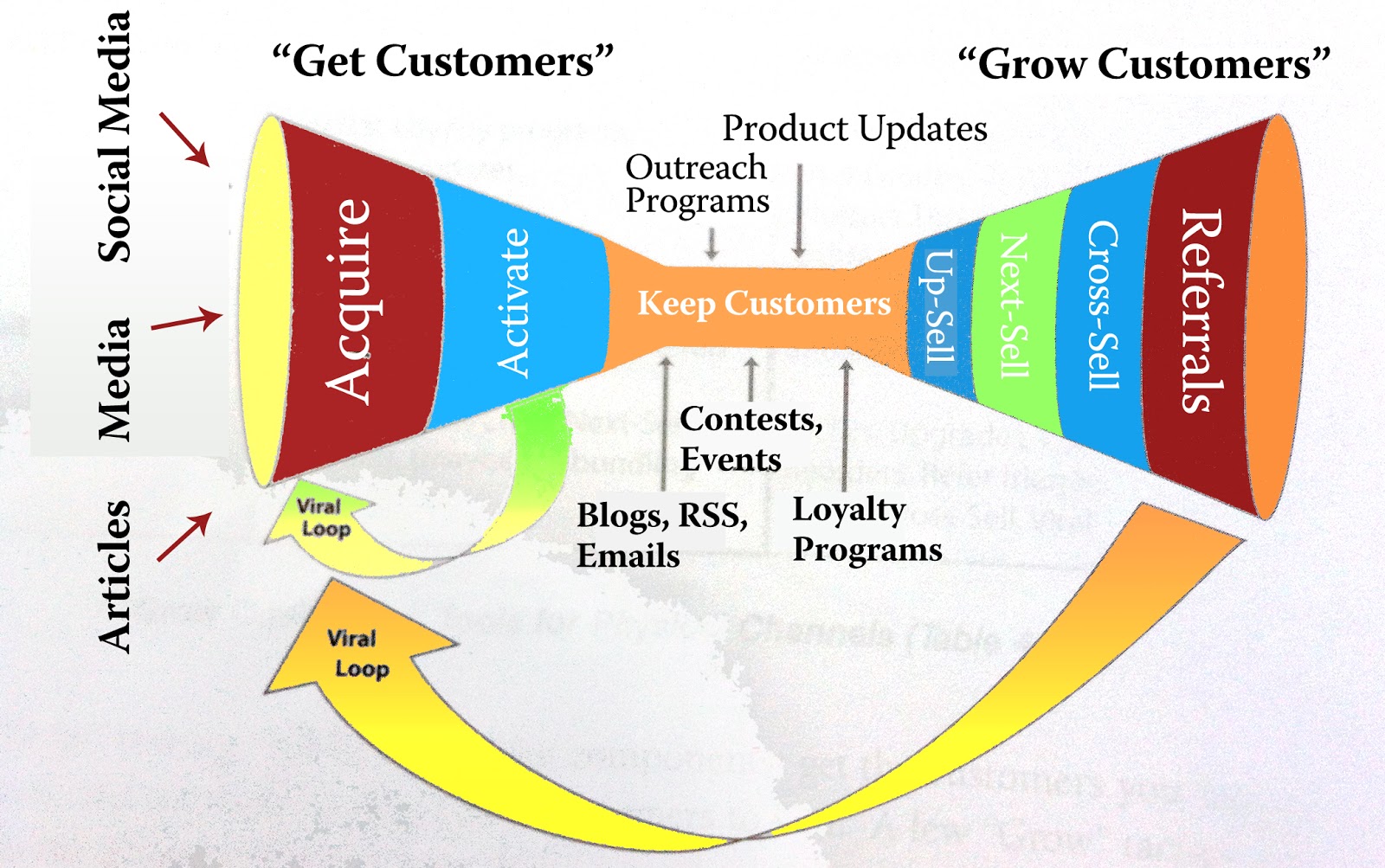
The double-sided sales funnel has two sides:
1. The left side has an overall theme, “get customers”:
- The top of the funnel is the acquisition stage of the top of the funnel, with articles, media, social media, and viral loops feeding into it.
- Next, is the middle of the funnel, which is about activating those leads to sign up.
- The bottom of the left side of the funnel is keeping customers, through outreach programs, product updates, blog articles, emails, contests, events, and loyalty programs.
2. The right side of the funnel’s overall theme is, “grow customers”:
- The top of the funnel is referrals, which are a fantastic way to get more business
- The top next stage is cross-selling, which is an excellent way to generate more sales with new and existing customers
- The next stage is next-sell. As Neil Patel, a marketing master, puts it: “This is when you follow up with a customer after purchase and offer them a similar product with, perhaps, an attractive discount attached.”
- The following stage is the up-sell, which targets people with extra attractive benefits and features for a fraction of the price. Fast food restaurants upsell all the time, saying: “would you like a large fry with that for only 50 cents more?”
- The bottom of the funnel is to keep customers through the previously mentioned tactics and strategies.
Optimizing the Buyer’s Journey with CRM
Your startup sales playbook finds an invaluable ally in CRM & email marketing tools. Here’s how:
- 360-Degree View: A CRM provides a comprehensive view of your leads and customers, allowing you to understand their journey across stages.
- Automated Nurturing: Use CRM and email marketing automations to streamline communications. Send targeted messages, trigger follow-ups, and nurture leads more effortlessly.
- Sales Forecasting: Leverage CRM analytics for sales forecasting. Understand which stages need attention, enabling strategic decision-making.
- Collaboration Across Teams: Sales, marketing, and customer support should collaborate. Share insights and align strategies for a seamless customer experience.
Enhancing Your Startup Sales Funnel: Key Strategies
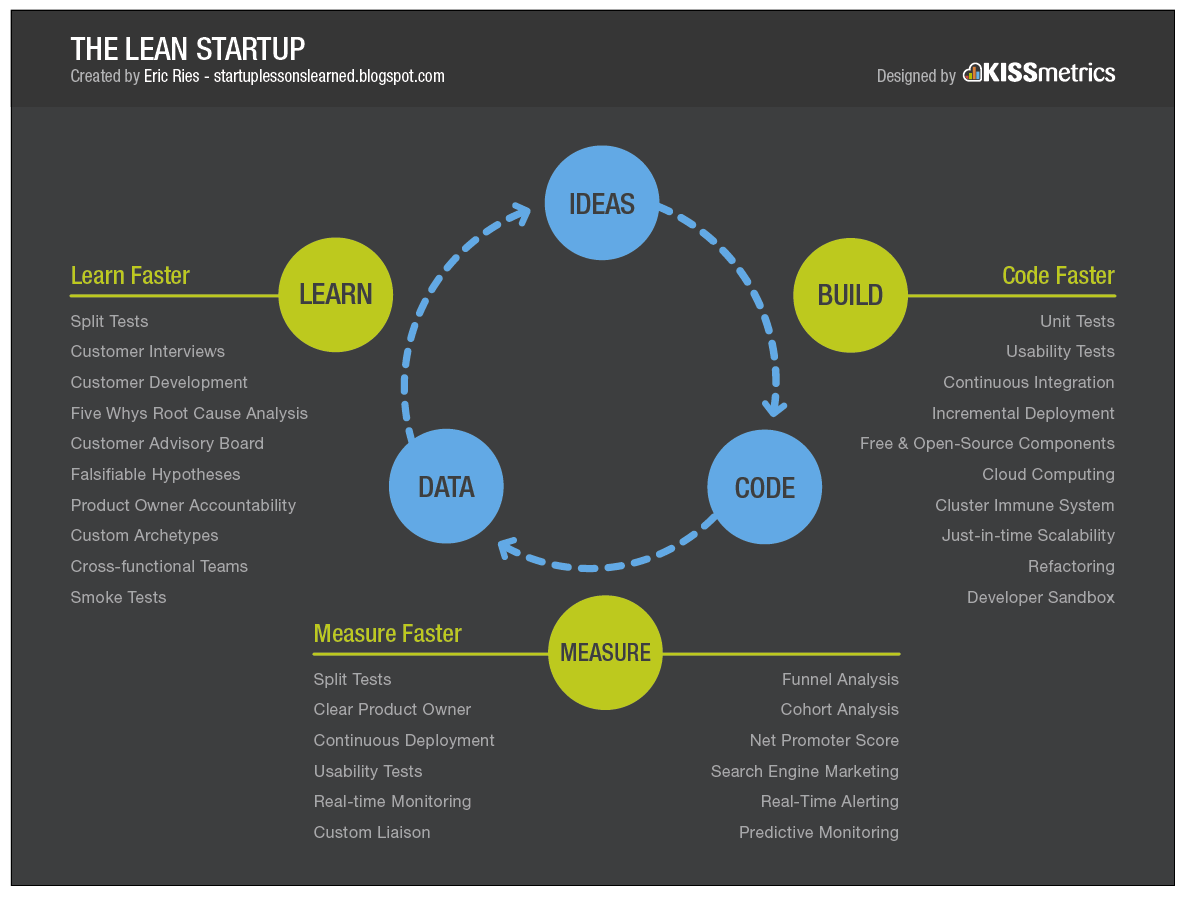
Incorporate these principles from the lean startup into your startup sales playbook for a refined and customer-centric approach:
1. Data-Driven Decisions:
Base your optimizations on real data. Dive into analytics, track customer journeys, and use A/B testing.
2. Iterative Refinement:
The sales funnel is not static. Embrace an iterative mindset. Test, learn, refine, and repeat.
3. Customer-Centric Approach:
Put your customers at the center. Understand their needs, listen to feedback, and adapt your funnel accordingly.
4. Collaboration Across Teams:
Sales, marketing, and customer support should collaborate. Share insights and align strategies for a seamless customer experience.
Embark on your startup sales playbook journey with CRM as your co-pilot, and watch as it transforms not just your funnel but your entire approach to sales. Let the startup sales playbook be your guide to sustained success.
12. Setting Clear Sales Objectives
Guiding Your Startup with SMART Sales Goals
Every successful journey begins with a clear destination. For startups, setting specific, measurable, achievable, relevant, and time-bound (SMART) sales objectives is the compass that points towards success.
In this section, we’ll explore the importance of well-defined sales goals, and how founders and marketers can achieve SMART goals through quant-based marketing and reverse-engineering, considering conversion rates.
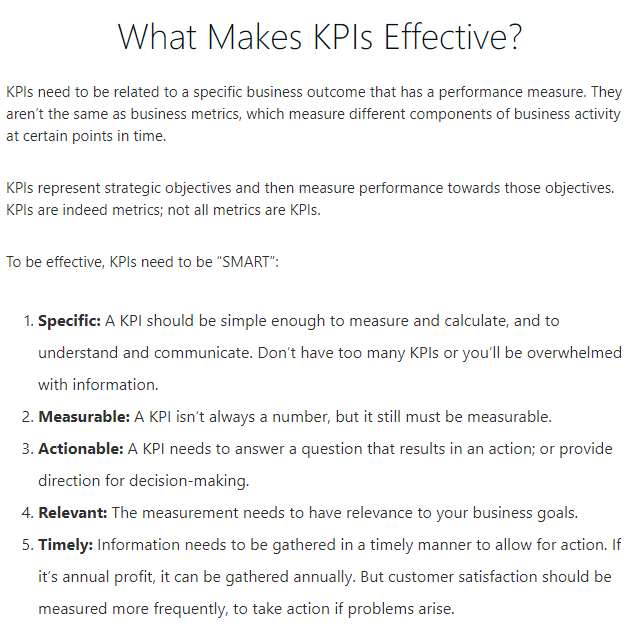
We’ll talk about key performance indicators more in two sections.
Establishing SMART Sales Goals
Setting SMART goals is the cornerstone of a successful sales playbook. Whether you’re a pre-seed founder, bootstrapped entrepreneur, or seed-stage visionary, aligning your team with specific objectives provides a roadmap for success.
1. How Do You Define SMART Sales Goals?
Start by identifying quantifiable targets, such as revenue milestones or customer acquisition numbers. Ensure these goals are realistic yet challenging, considering the stage of your startup. For instance, a pre-seed startup might aim for a certain number of pilot customers within the first quarter.
2. Achieving SMART Goals Through Quant-Based Marketing
Quant-based marketing involves using data and analytics to make informed decisions. Imagine you’re a seed-stage founder aiming to achieve a SMART goal of increasing monthly recurring revenue (MRR) by 20% in the next quarter.
You can reverse-engineer your goal for quant-based marketing.
It’s easy!
Say you want to get 100 customers and expect your conversion rate of leads will be 5%, that means you’ll need to contact 2000 prospects to achieve that goal.
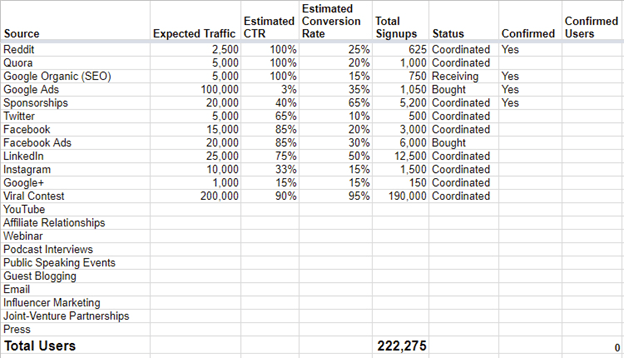
A) Leveraging Customer Segmentation and Analytics
Start by segmenting your customer base using your CRM. Identify high-value customers and understand their behaviors. Utilize analytics tools to track the customer journey, from awareness to conversion. Quantify key metrics such as customer acquisition cost (CAC), customer lifetime value (CLV), and conversion rates at each stage of the sales funnel.
B) Refining Strategies Based on Data Insights
Quant-based marketing allows you to pinpoint which channels are driving the most valuable customers. Suppose you discover that your content marketing efforts have a higher conversion rate compared to social media advertising. In that case, you can allocate more resources to content creation and refine your social media strategy to improve performance.
C) Implementing A/B Testing for Optimization
To further enhance your quant-based approach, employ A/B testing. Experiment with different elements in your marketing campaigns, such as ad copy, visuals, or call-to-action buttons. Analyze the performance of each variation and scale up strategies that yield the best results. This iterative process ensures continual improvement and alignment with your SMART goals.
D) Monitoring and Adjusting in Real-Time
Quant-based marketing is dynamic. With real-time monitoring, you can adapt to changing market conditions and customer behaviors promptly. If a particular marketing channel experiences a sudden drop in conversion rates, you can investigate and adjust your strategy before it significantly impacts your ability to achieve your SMART goals.
E) Continuous Optimization for Long-Term Success
By consistently applying quant-based marketing strategies, you not only meet short-term goals but also lay the foundation for long-term success. The iterative nature of data-driven decision-making ensures your marketing efforts remain aligned with your SMART sales objectives as your startup evolves.
2. Aligning Sales Objectives with Business Goals: Examples
Beyond quant-based strategies, aligning sales objectives with broader business goals is vital. These are quite similar to the OKRs (objectives and key results) framework that Google uses.
Let’s explore specific examples for startups:
Example 1: Market Expansion
Business Goal: Expand into new markets.
Sales Objective: Increase the number of qualified leads from untapped regions by 30% in the next quarter.
Alignment: By aligning sales objectives with the goal of market expansion, your team focuses on reaching potential customers in new territories.
Example 2: Product Innovation
Business Goal: Launch a new product or feature.
Sales Objective: Achieve a 15% increase in upsells or cross-sells related to the new offering.
Alignment: Sales efforts are concentrated on showcasing the value of the new product or feature, directly contributing to the business goal of innovation.
Example 3: Customer Retention
Business Goal: Improve customer retention rates.
Sales Objective: Implement a customer loyalty program and increase upsell rates by 20%.
Alignment: Sales teams work towards retaining existing customers by incentivizing loyalty, directly impacting the broader business goal.
3. The Impact of Aligned Objectives
According to a survey by Harvard Business Review, startups with aligned sales and business objectives experience 12% faster revenue growth. This highlights the direct correlation between clarity in goals and overall business success.
Regardless of what method you use, it’s important to stick with it until you’ve outgrown it and are ready to move on to a more sophisticated model that better serves your needs.
13. Essential Sales Metrics and KPIs
Understanding the heartbeat of your sales operations requires not just awareness but mastery of key metrics and performance indicators. For pre-seed, bootstrapped, and seed-stage founders, and the astute startup marketer, these metrics are the compass and charts for the unpredictable seas of startup growth. Let’s not just explore but demystify the crucial sales metrics, KPIs, and other key indicators that can illuminate your path.
Pirate Metrics
Using the pirate metrics framework could be very helpful in your sale pursuits and with keeping track of your metrics. See the image below how the activities align with the categories and see what you’ll be tracking within the “user status” category.
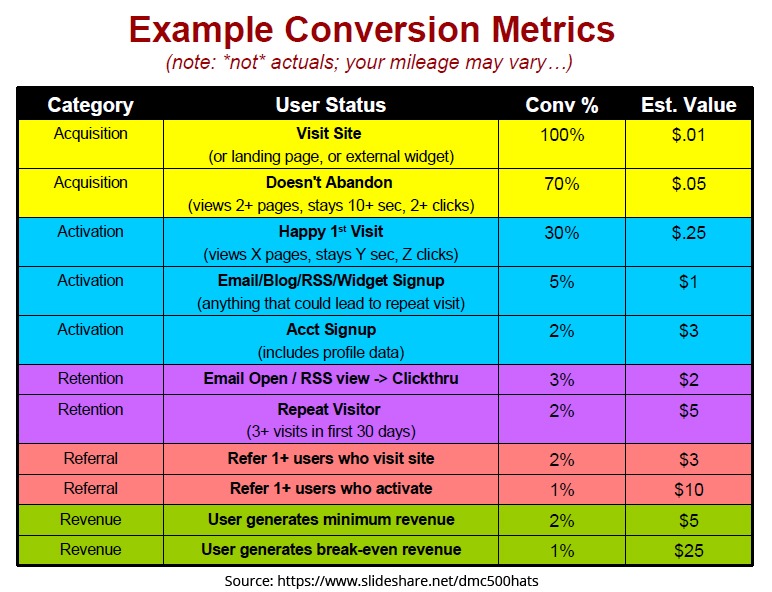
1. Lead Conversion Rate: Transforming Potential into Revenue
How to Calculate Lead Conversion Rate:
Lead Conversion Rate = (Number of Leads Converted into Customers / Total Number of Leads) × 100
![]()
Types of Tools:
- Analytics Tools
- CRM Platforms
Recommended Tools:
Why it Matters:
The Lead Conversion Rate is the heartbeat of your sales machinery, revealing how adeptly your team transforms potential interest into revenue. A high conversion rate signals not just sales success but the resonance of your product with your audience, ensuring the efficient use of resources and marketing efforts.
2. Customer Acquisition Cost (CAC): Balancing Investment and Returns
How to Calculate Customer Acquisition Cost:
CAC = (Total Costs Associated with Acquisition / Number of New Customers Acquired)

Types of Tools:
- Analytics Tools
- Customer Tracking Software
Recommended Tools:
Why it Matters:
In the intricate dance of acquisition and expenditure, CAC is your financial compass. Calculating the cost to acquire a new customer ensures that your investment aligns with returns. A lower CAC is not just a financial win; it’s a testament to strategic spending and a sustainable growth trajectory.
3. Average Deal Size: Decoding the Value You Deliver
How to Calculate Average Deal Size:
Average Deal Size = (Total Value of Deals Closed / Number of Deals Closed)
![]()
Types of Tools:
- CRM Platforms
- Sales Analytics Software
Recommended Tools:
Why it Matters:
Every closed deal carries a unique weight, and Average Deal Size is your gauge. This metric isn’t just a number; it’s a compass guiding your revenue forecasts and elucidating the value your product brings. Understanding and enhancing this metric is pivotal for strategic pricing and packaging, influencing your overall revenue stream.
4. Sales Cycle Length: Speeding Up Decision-Making
How to Calculate Sales Cycle Length:
Sales Cycle Length = (Total Days to Close Deals / Number of Deals Closed)

Types of Tools:
- CRM Platforms
- Sales Analytics Software
Recommended Tools:
Why it Matters:
In the fast-paced startup ecosystem, time is money. The Sales Cycle Length is not just a metric; it’s a reflection of your efficiency in closing deals. A shorter sales cycle not only signals swift decision-making but ensures agility in your approach, helping you capitalize on opportunities swiftly.
5. Customer Lifetime Value (CLV): Forging Long-Term Relationships
How to Calculate Customer Lifetime Value:
Customer Lifetime Value (CLV) = ((Average Purchase Value × Purchase Frequency × Customer Lifespan) / Churn Rate)

Types of Tools:
- Customer Analytics Platforms
- Subscription Management Software
Recommended Tools:
Why it Matters:
In the grand tapestry of startups, customers aren’t just transactions; they are relationships. CLV isn’t just a numerical triumph; it’s a validation of customer satisfaction, loyalty, and the long-term health of your startup. Understanding and optimizing CLV ensures a strategic focus on customer relationships and sustained growth.
6. Churn Rate: Safeguarding Customer Retention
How to Calculate Churn Rate:
Churn Rate = (Number of Customers Lost During a Period / Total Customers at the Start of the Period) × 100

Types of Tools:
- Customer Analytics Platforms
- Churn Prediction Software
Recommended Tools:
- Baremetrics
- Paddle (Formerly ProfitWell)
Why it Matters:
Customer retention is the backbone of sustained success, and Churn Rate is your guardian in this endeavor. This metric isn’t just a percentage; it’s a mirror reflecting your efforts in retaining customers. A low churn rate speaks volumes about the stickiness of your product or service, ensuring a steady ship amidst the waves of competition.
7. Sales Qualified Leads (SQLs): Focusing Efforts Where They Matter
How to Calculate Sales Qualified Leads:
Sales Qualified Leads (SQL) Rate = (Number of Sales Qualified Leads / Total Number of Leads) × 100

Types of Tools:
- Lead Generation Software
- CRM Platforms
Recommended Tools:
Why it Matters:
Not all leads are created equal, and focusing on Sales Qualified Leads ensures your efforts are concentrated where they matter most. This metric isn’t just a rate; it’s a strategic filter, maximizing efficiency and boosting conversion rates. As you optimize your sales strategies, the emphasis on SQLs is pivotal for effective resource allocation.
8. Opportunity Win Rate: Gauging Sales Effectiveness
How to Calculate Opportunity Win Rate:
Opportunity Win Rate = (Number of Closed Deals / Number of Opportunities) × 100
![]()
Types of Tools:
- Sales Analytics Software
- CRM Platforms
Recommended Tools:
Why it Matters:
The pursuit of opportunities is at the core of every startup’s journey. Opportunity Win Rate isn’t just a percentage; it’s a litmus test of your sales team’s effectiveness. A high win rate is a testament to the prowess of your sales strategies and the resonance of your offerings in the market, influencing your overall sales effectiveness.
9. Customer Satisfaction (CSAT) Score: Orchestrating Delight
How to Calculate Customer Satisfaction Score:
Customer Satisfaction (CSAT) Score = (Sum of Positive Responses / Total Number of Responses) × 100
Types of Tools:
- Customer Feedback Platforms
- Helpdesk Software
Recommended Tools:
Why it Matters:
In the age of customer-centricity, satisfaction is the currency of success. CSAT Score isn’t just a number; it’s a barometer measuring how content your customers are with your product or service. A high CSAT score isn’t just a badge of honor; it’s a roadmap to customer delight and loyalty, laying the foundation for sustained growth.
10. Referral Rate: Harnessing the Power of Advocacy
How to Calculate Referral Rate:
Referral Rate = (Number of Referrals / Total Number of Customers) × 100
![]()
Types of Tools:
- Referral Marketing Software
- CRM Platforms
Recommended Tools:
Why it Matters:
Word-of-mouth is a force multiplier in the startup realm, and Referral Rate captures this phenomenon. This metric isn’t just a rate; it’s a manifestation of satisfied customers becoming advocates. A high referral rate isn’t just a numerical accolade; it’s a testament to organic growth and market expansion, showcasing the power of customer advocacy.
11. Sales Pipeline Velocity: Accelerating Revenue Generation
How to Calculate Sales Pipeline Velocity:
Sales Pipeline Velocity = ((Number of Opportunities × Average Deal Value) / Average Sales Cycle Length (in Days)))
![]()
Types of Tools:
- Sales Analytics Software
- CRM Platforms
Recommended Tools:
Why it Matters:
In the hustle and bustle of startup life, speed is often a differentiator. Sales Pipeline Velocity isn’t just a calculation; it’s a gauge of the pace at which opportunities move through your sales pipeline. A higher velocity accelerates revenue generation and signifies the efficiency of your sales process, ensuring your startup remains agile and responsive.
12. Email Response Rate: Crafting Engaging Connections
How to Calculate Email Response Rate:
Email Response Rate = (Number of Responded Emails / Total Number of Sent Emails) × 100
Types of Tools:
- Email Marketing Platforms
- CRM Platforms
Recommended Tools:
Why it Matters:
Emails are the unsung heroes of modern communication, and Email Response Rate is your litmus test for engagement. This metric isn’t just a rate; it’s an affirmation of your ability to craft compelling, engaging connections with your audience. A high response rate ensures that your outreach efforts resonate with your audience, fostering meaningful connections.
Additional Metrics for Holistic Startup Insights:
Burn Rate:
Burn Rate = (Total Operating Expenses / Total Cash Available) × 100
![]()
Monthly Recurring Revenue (MRR):
MRR = (Average Revenue per User/Unit) x Total Number of Users/Units
Tools: Subscription Management Platforms, Financial Management Platforms
MRR provides insights into the recurring revenue generated by your subscription-based model. Subscription management platforms and financial tools assist in computing MRR accurately.
Click-Through Rate (CTR):
CTR = (Number of Clicks on an Ad or Link / Number of Impressions) x 100
![]()
Types of Tools:
- Digital Marketing Platforms
- Analytics Tools
Recommended Tools:
- Google Analytics
- Rebrandly (Formerly ClickMeter)
Why it Matters:
In the digital landscape, visibility is just the first step; interaction is the true goal. CTR isn’t just a percentage; it’s a metric reflecting the resonance of your content or ads. A high CTR signifies not just visibility but active engagement, ensuring that your digital efforts translate into meaningful connections and, potentially, conversions.
These metrics and KPIs, coupled with the right tools, provide a comprehensive dashboard for your startup’s health and growth trajectory. Regularly measuring, analyzing, and adapting based on these indicators empower you to make informed decisions and steer your startup toward strategic success.
Learn more about KPIs here: 34 Types Of Startup KPIs & Metrics To Measure With Examples
14. Conclusion
Navigating the Sales Landscape with Confidence
Congratulations on reaching the culmination of your journey into the intricacies of startup sales. In this dynamic realm where art and science converge, mastering the craft of sales empowers founders and marketers to propel their startups toward sustainable growth and enduring success.
1. The Holistic Sales Playbook
Your startup sales playbook is more than a set of strategies; it’s a dynamic guide that evolves with your business. It encompasses the artistry of storytelling, the precision of data-driven decisions, and the human touch of authentic connections.
How often should I update my sales playbook?
Regularly revisit and update your playbook, especially when there are significant shifts in your target market, industry trends, or the competitive landscape.
2. Continuous Learning and Adaptation
In the ever-evolving landscape of sales, the commitment to continuous learning is non-negotiable. Stay abreast of emerging technologies, evolving consumer behaviors, and innovative sales methodologies.
According to Deloitte, companies with a culture of continuous learning are 46% more likely to be leaders in their industry.
3. Customer-Centricity as the North Star
Amidst the metrics and strategies, never lose sight of the heartbeat of sales—your customers. Center your efforts around understanding their needs, addressing their pain points, and providing solutions that genuinely enhance their lives.
How can I ensure a customer-centric approach in all stages of the sales process?
Regularly seek customer feedback, involve them in product development decisions, and prioritize customer success as a key performance indicator.
4. Building a Resilient Sales Team
A study by Gallup found that companies with high employee engagement are 21% more profitable. For founders, CEOs, and marketers, building and nurturing a resilient sales team is a cornerstone of success. Invest in their training, provide avenues for professional growth, and foster a culture that celebrates both successes and learning experiences.
5. Embracing Innovation and Adaptability
As you embark on this sales journey, embrace innovation and adaptability as your allies. The ability to pivot, experiment with new approaches, and incorporate feedback positions your startup for resilience in the face of changing market dynamics.
How do I balance innovation with consistency in my sales approach?
Innovation doesn’t always mean drastic changes. Incremental improvements, A/B testing, and refining existing processes contribute to an innovative and adaptive sales strategy.
Final Words: Your Sales Odyssey Begins
With the insights gained from this comprehensive sales playbook, you’re equipped to navigate the intricate seas of startup sales. Whether you’re a pre-seed founder, a bootstrapped entrepreneur, or a seed-stage visionary, your sales odyssey is a continuous exploration of growth, learning, and impactful connections.
As you embark on this journey, remember that success in sales is not a destination but a perpetual expedition. Stay agile, embrace the ever-evolving landscape, and let your startup sales playbook be the compass guiding you toward unprecedented heights.
What is the most crucial piece of advice for startup founders diving into sales?
Stay true to your vision, be resilient in the face of challenges, and view each interaction as an opportunity to learn and grow. Your commitment to your mission will resonate with your audience and propel your startup toward enduring success.
